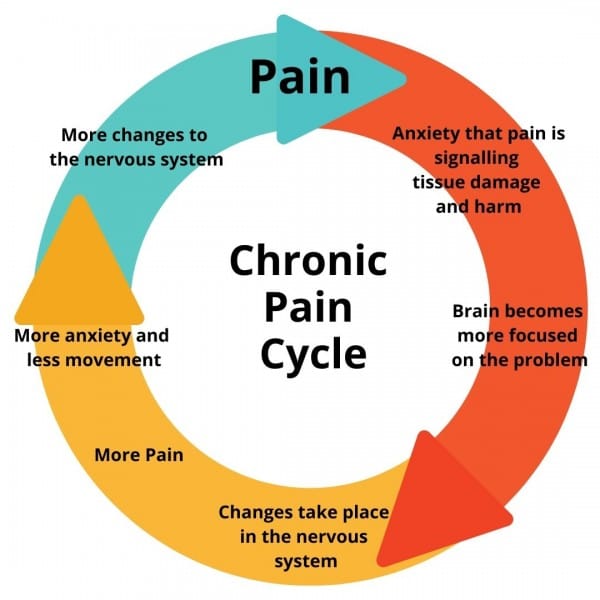Chronic pain, a persistent discomfort that lasts for more than three months, can significantly impact quality of life. Unlike acute pain, which typically results from an injury and subsides as the body heals, chronic pain persists for months or even years, often without a clear cause.
Effective management requires a multifaceted approach, including understanding the condition, seeking professional help, and incorporating lifestyle changes.
Understanding Chronic Pain
Chronic pain is often a complex issue with various underlying causes, such as injuries, illnesses, or neurological conditions. It can be a debilitating experience, leading to emotional distress, sleep disturbances, and social isolation. While there may not be a cure, effective management strategies can help individuals cope and improve their overall well-being.

Picture Credit: Capital Area Physical Therapy and Wellness
The pain cycle refers to the self-perpetuating loop in which chronic pain leads to emotional, psychological, and physical responses that, in turn, intensify or prolong the pain. This cycle is common in individuals dealing with long-term pain and can be difficult to break without a comprehensive management plan.
Common Types of Chronic Pain:
- Lower Back Pain: Often caused by issues like herniated discs or spinal conditions.
- Arthritis Pain: Inflammation in the joints can cause persistent discomfort.
- Neuropathic Pain: This type of pain results from nerve damage, often felt as a burning or tingling sensation.
- Headaches and Migraines: Chronic headaches can disrupt daily life and often require specialized treatments.
- Fibromyalgia: A condition that causes widespread muscle pain and tenderness, often accompanied by fatigue.
Causes of Chronic Pain
Chronic pain can stem from a variety of causes, and sometimes, the exact cause remains unknown. Here are some common sources:
- Injuries: Past injuries, even when healed, can leave behind lingering pain.
- Medical Conditions: Diseases like arthritis, diabetes, and fibromyalgia are known to cause chronic pain.
- Nerve Damage: Neuropathic pain often arises from nerve injury or damage, such as after surgery or trauma.
- Inflammation: Conditions that cause inflammation, such as autoimmune diseases, can result in long-lasting pain.
- Psychological Factors: Stress, anxiety, and depression can exacerbate or even trigger chronic pain.
The Importance of Physiotherapy for Chronic Pain
Physiotherapy plays a crucial role in chronic pain management. A qualified physiotherapist can assess the root cause of the pain, develop a personalized treatment plan, and provide guidance on exercises and techniques to alleviate discomfort and improve function. Through targeted interventions, physiotherapy can help individuals regain strength, flexibility, and mobility, ultimately reducing pain and enhancing quality of life.
Managing Chronic Pain: Treatment Options
While chronic pain may not always be curable, it is manageable. A combination of therapies often yields the best results. Below are common methods used to treat and manage chronic pain:
1. Medications:
- Over-the-counter Pain Relievers: Nonsteroidal anti-inflammatory drugs (NSAIDs) like ibuprofen or acetaminophen are often the first line of defense.
- Prescription Medications: In more severe cases, doctors may prescribe opioids, muscle relaxants, or antidepressants that also help relieve pain.
- Topical Treatments: Creams and patches containing pain-relief ingredients can be applied directly to the skin to ease localized pain.
2. Physiotherapy:
- Physiotherapy aims to strengthen muscles, improve flexibility, and reduce pain through movement. A tailored exercise plan can help prevent stiffness and alleviate chronic pain.
3. Cognitive Behavioral Therapy (CBT):
- Chronic pain can have a significant psychological impact. CBT helps patients manage their pain by changing the way they perceive and react to it. This therapy is also useful for dealing with anxiety and depression related to chronic pain.
4. Alternative Therapies:
- Acupuncture: This traditional Chinese medicine technique involves inserting thin needles into specific points of the body to reduce pain.
- Massage Therapy: Gentle massage can help relax muscles and reduce pain in some cases.
- Yoga and Meditation: Mind-body practices like yoga and meditation can help reduce stress, improve flexibility, and alleviate pain.
5. Lifestyle Changes:
While chronic pain can be difficult to prevent entirely, adopting healthy lifestyle habits can significantly reduce the risk and severity of symptoms. Regular exercise, a balanced diet, adequate sleep, and stress management techniques are essential components of a comprehensive approach. By addressing underlying health conditions and making positive lifestyle choices, individuals can improve their overall resilience and reduce the impact of chronic pain
For more information on how to reduce or manage chronic pain with physiotherapy, contact us at 416.207.9911 to make an appointment at one of our physiotherapy clinics:




